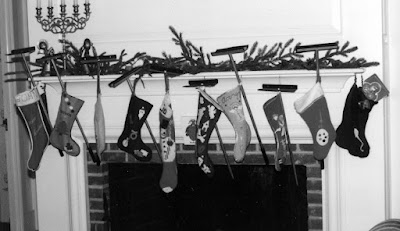Holidays are full of tradition and our home is no exception. It’s a tradition that I string lights outside. It’s a tradition that I pull the boxes of decorations down from the attic and it’s a tradition that I assemble the artificial tree.
Some traditions I carried forward from my childhood and others I inherited from my in-laws. Still, they are all traditions and Christmas doesn’t seem complete without them.One tradition that I inherited from my in-laws was stocking stuffers. No matter how much preparation and shopping went into Christmas for five children, Gladys Brownrigg left the stockings to John, my father-in-law.
John was an engineer and a salesman and a guy who loved gadgets. He took the role of stuffing stockings away from Santa as the kids grew older and seemed to enjoy filling them with objects that teenagers might find useful as they became more independent.
Kiddie toys had been replaced with tape measures, mini screwdriver sets, penknives, flashlights and even ice scrapers. As boyfriends (and future husbands) joined the family for Christmas morning, they too opened stockings that would make a Brookstone salesman smile. Thirty years later, many of the small tools and gadgets we received are still in use at our house.
John’s most memorable stocking stuffers came from a company called The Thomas Registry Catalog. The useful catalog sometimes referred to as ThomCat was a comprehensive listing of companies and products manufactured in the United States. Each year ThomCat would send John promotional and novelty items with the familiar ThomCat logo as thanks for purchasing the catalog.
He didn’t appreciate the gesture thinking they could use the money in a better way – like charging less for the catalog. So he saved all of the items over a number of years with the intention of sending them back to the company in protest. That never happened.
Instead, the Brownrigg kids and various son-in-laws received ThomCat promotional items in their stockings. There were umbrellas, barbeque aprons, belt buckles, pens, Frisbees, sunglasses, playing cards, and many other items emblazoned with the ThomCat logo. I have no recollection of what gifts were exchanged that year but everyone remembers it as the ThomCat Christmas.”
The tradition of Christmas stockings is hard to trace but a popular legend says that St. Nicholas visited the home a poor family and placed gold coins in stockings they had hung to dry by the fireplace. Thus was born the tradition of placing stockings over the fireplace to be filled by St. Nick.
Now that the kids are no longer “kids” and the days of Hot Wheels and Polly Pockets are gone, I no longer have to sneak in like St. Nicholas but I take the search for useful gadgets and tasty treats seriously.
I have no idea what that those gadgets will be but I still have lots of time. You see…stocking stuffer procrastination is another tradition I inherited from my father in-law.
























